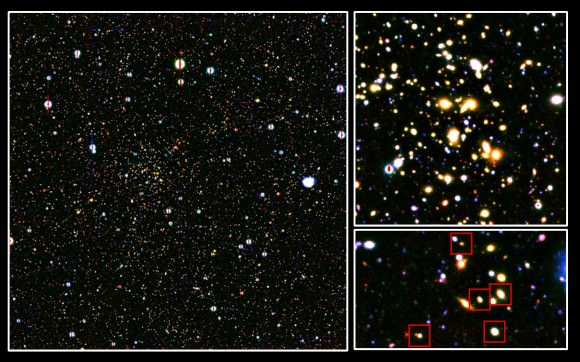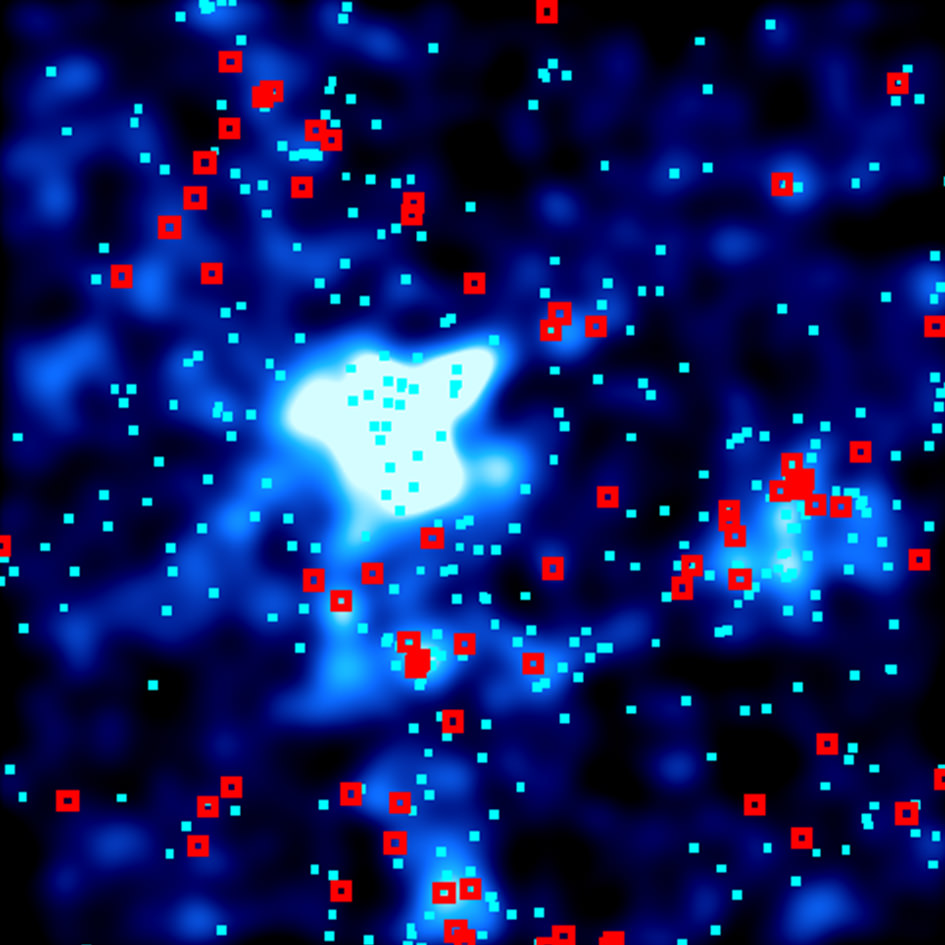[/caption]
Utilizing the Subaru Telescope, a research team of astronomers from the University of Tokyo and the National Astronomical Society of Japan (NAOJ) used a wide-field image to take a look four billion years back in time. The object of their interest was a galaxy cluster, but what really took their fancy wasn’t the old matrons – it was the red star-forming galaxies hanging around the edges.
Just exactly what is a “red-burning galaxy”? Astronomers hypothesize they might be the transitional key between the young and old… and present at a party that shows dramatic evolution. It’s not the fact that such galaxies exist within galactic clusters, but why they seem to appear along the outskirts.
When galaxies first began forming under the weight of their own gravity some ten billion years ago, they either became part of big clusters or small groups. As they came together, they took on properties of their environment – just as party goers tend to group together where interests are similar. At a galactic get-together with high density, galaxies form into lenticular or elliptical, while the solitary wall flowers tend toward spiral structure. But exactly how they form and evolve is one of astronomy’s greatest enigmas.

To help solve the mystery, researchers are looking further back into the past. A research team led by Dr. Yusei Koyama used the Subaru Prime Focus Camera (Suprime-Cam) to carry out a panoramic observation targeting a relatively well-known rich cluster, CL0939+4713. By using a special filter that separates the hydrogen-alpha emission lline Koyama’s team members identified more than 400 galaxies showing a narrowband excess which could denote the star formation process. Strangely enough, it was these very galaxies that showed an impressive amount of red and were located in groups well away from the main body.
Needless to say, this opened the door to even more questions. Where did they come from and why are they concentrated in groups and not clusters? At this point, who knows? Astronomers are positive the “red-burning galaxies” get their properties from starbirth – not elderly populations. They also anticipate the main galaxy cluster will one day absorb these strays into the main body as well. How can they tell? Just like the party, the red-burning galaxies are already changing in relationship to their environment. Older galaxies that no longer have active star-forming regions seem to be increasing in the groups, exactly where the red-burners are most frequently found.
“This suggests that the red-burning galaxies are related to the increase in old galaxies, and that they are likely to be in a transitional phase from a younger to an older generation. The finding that such transitional galaxies are located most frequently within group environments shows that galaxy groups are the key environments for understanding how environment shapes the evolution of galaxies.” says the Subaru research team. “This should be an important and exciting step toward a more complete understanding of the environments shaping the galaxies in the present-day Universe.”
Party on, dudes…
Original Story Source: Subaru Telescope Press Release.


Yo Tammy, at the third paragraph, in both the second and fourth sentences, there is a missing “y” in what should be they, not “the”.
Also, in the fourth paragraph, at the end of the fourth line, there’s a double “l” in line.
gotcha’. thanks for keeping me a legal beagle! (and here i thought i was gonna’ slip another one by you with no mistakes!)
gotcha’. thanks for keeping me a legal beagle! (and here i thought i was gonna’ slip another one by you with no mistakes!)
Just simply beautiful and awesome!
It is interesting to ponder why these red H-a emitting galaxies inhabit the fringes of this cluster either alone or in small groups. In reading the current paper( http://arxiv.org/PS_cache/arxiv/pdf/1103/1103.2180v2.pdf ) the authors mention previous work they did using Subaru to identify a galaxy cluster at z=0.8 that also exhibited a similar pattern with reddish, H-a emitting galaxies preferentially arranged at the cluster’s outskirts. The authors concluded that these were mainly caused by interactions in the cluster halo that was stripping the galaxies such that they are regarded as precursors to S0 galaxies once they begin their infall into the cluster center. The paper is available here: http://arxiv.org/PS_cache/arxiv/pdf/0912/0912.2786v2.pdf
The great number of H-a emitting galaxies in the densest parts of this clusters belies its relative youth. Large galaxy clusters near us like Virgo, Coma and Perseus are pretty much devoid of such star forming galaxies at their centers, indicating they are largely depleted of materiel required to make new stars.
In contrast, many galaxies near the densest parts of CL 0939+4713 (Abell 851) show tell-tale signs of star birth with their H-a glow, indicating that Abell 851 appears “younger” and less evolved than nearby rich galaxy clusters.